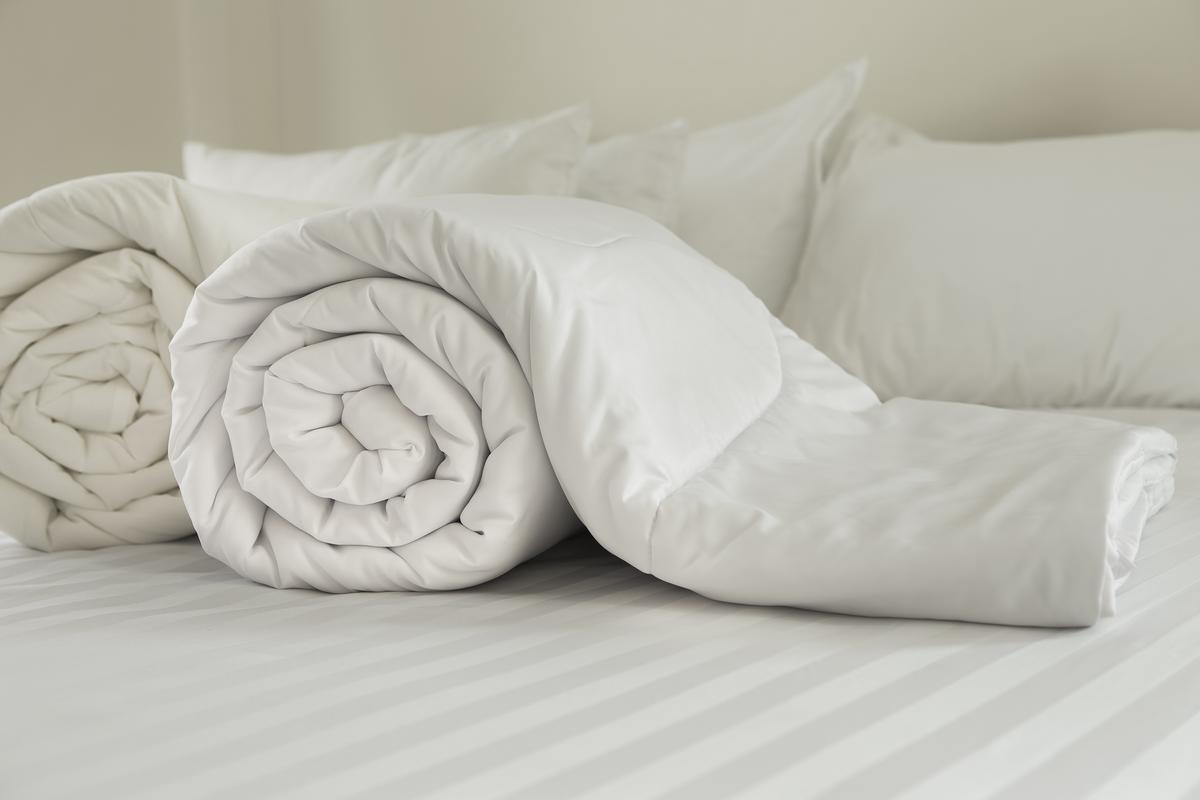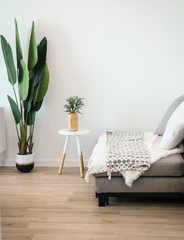Down vs. Synthetic Fillings: Pros and Cons for Your Bed
Creating the perfect sleep environment is crucial for a good night's rest, and what you choose to fill your bedding with can make all the difference. When it comes to choosing between down and synthetic fillings for your bed, there are plenty of factors to consider. Do you prioritize luxury and natural materials? Or perhaps you value affordability and easy maintenance? In this blog post, we'll explore the pros and cons of both down comforters and synthetic fillings so that you can make an informed decision on which option is best suited for your sleeping needs. Let's dive in.
What are Down Comforters made of?
Down comforters are a popular choice for those seeking luxurious and cozy bedding. But what exactly is down? Well, it's the soft layer of fine feathers found beneath the tougher exterior feathers of ducks or geese. These down clusters have exceptional insulating properties, providing warmth without weight.
The most sought-after down comes from geese, as their larger clusters offer superior loft and insulation. To ensure ethical sourcing, look for products labeled as "responsibly sourced" or "RDS certified," indicating that the feathers were obtained humanely.
When it comes to construction, down comforters typically feature baffles or squares stitched into the fabric to keep the filling evenly distributed throughout. This prevents clumping and ensures consistent warmth across your entire bed.
For those with allergies or sensitivities, fear not! High-quality down comforters undergo rigorous cleaning processes that remove allergens and impurities. And if you're concerned about maintenance, many options can be machine-washed on gentle cycles.
With its natural breathability and ability to adapt to body temperature changes, a down comforter offers unparalleled coziness during any season. It's no wonder they've been cherished by sleep enthusiasts for centuries!
What are the benefits of using a Down Comforter?
When it comes to choosing bedding accessories, a down comforter can be an excellent choice for many reasons. First and foremost, down comforters provide exceptional warmth and insulation, making them perfect for cold winter nights or chilly climates. The natural properties of down feathers trap heat effectively, allowing you to stay cozy without feeling weighed down.Another advantage of using a down comforter is its breathability. Unlike synthetic fillings that may restrict airflow, down allows moisture to evaporate easily, preventing overheating during sleep. This ensures that you maintain a comfortable body temperature throughout the night.
Down comforters also offer superior softness and luxury. The fluffy clusters of down create a plush sleeping surface that feels incredibly indulgent. Additionally, their lightweight nature adds to the overall comfort level as they drape gently over your body.
Durability is another benefit of using a down comforter. With proper care and maintenance, these high-quality bedding options can last for many years.
Down is considered hypoallergenic when cleaned properly and used with an appropriate duvet cover that prevents dust mites from penetrating the fabric.
If you value warmth without weightiness, breathability for optimal temperature regulation during sleep cycles, luxurious softness paired with durability in your bedding choices; then investing in a high-quality down comforter could be an ideal solution for your bedroom decor and personal sleep preferences
What are Down Comforters?
Down comforters are a popular choice for bedding fillings due to their luxurious and cozy feel. But what exactly is down? Well, it's the soft, fluffy plumage found beneath the feathers of ducks and geese. This natural material is known for its exceptional insulation properties, making it perfect for keeping you warm during chilly nights.
One of the key benefits of down comforters is their ability to regulate body temperature. The clusters of down trap air pockets that provide insulation without causing overheating. This means you can stay comfortably warm without feeling too hot or sweaty.
Down comforters offer excellent breathability. The natural materials allow moisture to escape, preventing any buildup that could disrupt your sleep quality. Plus, they're lightweight yet incredibly effective at providing warmth, giving you a cloud-like experience every night.
It's worth noting that not all down comforters are equal in terms of quality and fill power. Higher-quality options will have larger clusters with more loft, resulting in better insulation and overall performance.
If you're looking for a bedding filling that offers unparalleled softness and warmth while regulating your body temperature effectively, then a down comforter may be the perfect choice for your bed!
What are Synthetic Fillings?
Synthetic fillings as the term suggests, are man-made materials that are used to fill bedding items such as pillows and comforters. Unlike down fillings which come from natural sources synthetic fillings are usually made from polyester fibers or microfibers.One of the main benefits of synthetic fillings is their hypoallergenic properties. For people who suffer from allergies or have sensitivities to natural materials synthetic fillings can be a great alternative. They do not contain any feathers or animal products, reducing the risk of triggering an allergic reaction.
Another advantage of synthetic fillings is their affordability. Compared to down comforters and pillows which can be quite expensive due to the higher cost of sourcing and processing natural materials, synthetic alternatives offer a more budget-friendly option without compromising on quality.
Synthetic fillings tend to be easier to care for. They can often be machine washed and dried without losing their shape or loftiness. This makes them ideal for those who prefer low maintenance bedding options.
One potential drawback of synthetic fillings is that they may not provide the same level of insulation as down fillings. Down has excellent thermal properties and can regulate body temperature effectively whereas synthetics may retain heat more than desired in warmer climates.
While there are pros and cons to both down and synthetic filling options for your bedding needs, it ultimately comes down to personal preference and specific requirements. If you prioritize warmth and luxury feel over affordability and ease of maintenance then down might be your best choice. On the other hand, if hypoallergenic properties and value for money are important factors for you then opting for high quality synthetic filled products would make sense.
Pros and Cons of Down Comforters
Down comforters, filled with the soft and insulating feathers from ducks or geese, have long been a popular choice for bedding. But like any product, they come with their own set of pros and cons.
One of the biggest advantages of down comforters is their exceptional warmth. The natural insulation provided by the down feathers traps heat efficiently, making them perfect for chilly nights. Additionally, down comforters are lightweight and provide a cozy and cloud-like feel that many sleepers find incredibly comfortable.
On the downside one common concern with down comforters is allergies. Some people may be allergic to the proteins found in bird feathers and experience symptoms such as sneezing or breathing difficulties when using a down-filled duvet. Another disadvantage is that maintaining a down comforter can be more challenging compared to synthetic options. They require careful cleaning procedures to ensure that they retain their loftiness and don't clump together.
Cost can also be a drawback when it comes to purchasing a high-quality down comforter. Genuine goose or duck feather fillings tend to come with a higher price tag than synthetic alternatives due to their superior insulation properties.
While down comforters offer excellent warmth and luxurious coziness, potential issues with allergies and maintenance should be considered before making your purchase decision
What are the Different Types of Synthetic Fillings?
Synthetic fillings offer an alternative to down comforters and pillows, providing a hypoallergenic option for those with allergies or sensitivities. There are several different types of synthetic fillings available on the market today.
One popular type is polyester fiberfill, which is made from finely spun polyester fibers. This type of filling provides good insulation and loft, making it fluffy and comfortable to sleep on. It is also lightweight and machine washable, making it easy to care for.
Another common type of synthetic filling is microfiber. Microfiber consists of ultra fine synthetic fibers that mimic the softness and loftiness of natural down. This material is often used in high-quality bedding products as it offers excellent breathability and moisture-wicking properties.
Gel filled synthetic fillings are another option worth considering. These gel-infused materials provide enhanced cooling properties, perfect for individuals who tend to overheat during sleep. The gel helps regulate body temperature by dissipating heat away from the body.
There are also blended synthetic fills available on the market that combine various types of materials such as microfiber and polyester fiberfill. These blends aim to provide a combination of benefits like softness, durability, and affordability.
When choosing a synthetic filling for your bedding needs, consider factors such as personal preferences (e.g., firmness), allergies or sensitivities you may have (opting for hypoallergenic options), ease of maintenance (machine washable vs dry clean only), as well as budget considerations.
there are various options when it comes to selecting a synthetic filling for your bed linens or pillows. Each type has its own unique features and benefits that cater to different sleep preferences and needs.
By exploring these options thoroughly before making a purchase decision,
you can find the perfect synthetic filling that meets your requirements while ensuring maximum comfort throughout the night.
Remember that understanding what each type offers allows you
to make an informed choice that will result in a cozy and restful sleep experience.
When it comes to choosing the right filling for your bedding, there is no one-size-fits-all answer. Both down and synthetic fillings have their own set of pros and cons that you should consider before making a decision.
Down comforters offer exceptional warmth, lightweight feel, and excellent insulation properties. They are also known for their durability and ability to regulate body temperature effectively. However, they may not be suitable for individuals with allergies or those who prefer cruelty-free products.
On the other hand, synthetic fillings provide hypoallergenic options that are ideal for people with sensitivities or allergies. These fillings are often more affordable compared to down comforters and can still provide good insulation properties. Synthetic materials also tend to be easier to clean and maintain.
The choice between down and synthetic fillings depends on your personal preferences, budget, environmental concerns, and any specific allergy considerations you may have. It's important to try out different options if possible or seek advice from experts in order to find the perfect bedding filling that suits your needs best.
Whether you opt for luxurious down comforters or practical synthetic alternatives, investing in high-quality bedding will undoubtedly enhance your sleep experience overall. Remember that a comfortable bed leads to better restful nights which then contribute positively towards your overall well-being.
So go ahead explore the wonderful world of bedding fillings and create a cozy sanctuary where dreams come true.
Frequently Asked Questions (FAQs)
Are synthetic fillings as warm as down?
Synthetic fillings can provide warmth, but they may not be as effective at retaining heat as down. It depends on the specific synthetic material used.
Can I machine wash bedding with down fillings?
It's generally not recommended to machine wash bedding with down fillings, as it can damage the down clusters. Dry cleaning or spot cleaning is often a better choice.
Do synthetic fillings clump over time?
While synthetic fillings are designed to resist clumping, they may still require occasional fluffing to maintain their loft.
Are down fillings cruelty-free?
Down fillings are typically sourced from ducks or geese, which may involve practices that some consider unethical. Look for responsibly sourced down if you have concerns about animal welfare.
Which filling is more eco-friendly?
Down is a natural and biodegradable material, making it a more eco-friendly choice compared to synthetic materials, which do not biodegrade.
Can I find a balance between comfort and allergies in bedding?
Yes, you can opt for hypoallergenic down fillings or explore synthetic options designed to mimic the comfort of down while being allergy friendly.


